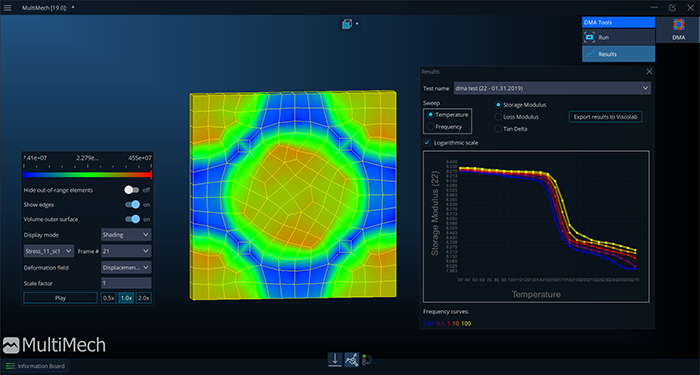MultiMechanics, an Omaha-based developer of multiscale composite modeling and simulation software, has announced the release of MultiMech 19.0. The release will improve the breadth and run times of multiscale composite simulations.
“This will help get materials to market faster,” said Dr. Flavio Souza, MultiMechanics President & CTO. “We can speed up that process through simulation, which is 10 to 100 times faster than doing physical experiments.”
Composite materials are currently transforming the transportation industry by improving efficiency, lowering emissions, and decreasing fuel consumption. However, the current process for adopting these advanced materials is time sensitive and can cost millions in testing and certification. To help address these challenges, MultiMech 19.0 delivers new material models, new damage scenarios, faster run times, and expanded integration with commonly-used FEA systems.
“As the use of material modeling and simulation software expands, material scientists are demanding more accurate results without compromising speed and functionality, as well as easier and more integrated workflows,” Souza said. “MultiMech 19.0 marks the significant progress we have made towards closing that gap.”
Among the features of the release is a new bi-modulus elastic model that will enable engineers to better capture the mechanical behavior of carbon fibers. In addition to exhibiting nonlinear elastic behavior at small deformation, carbon fibers also possess different mechanical properties in tension and compression, making them especially difficult to model and simulate. MultiMech 19.0 allows engineers to more realistically predict the behavior of these materials.
“These are new, mature models specifically for carbon fiber testing,” Souza said. “They are physics-based simulation tools that can replace physical testing.”
Among the other features of MultiMech 19.0:
Solver speed-up of 1.5x
The solver speed-up will allow engineers to take advantage of the accuracy of a concurrent multiscale approach while benefiting from increased speed.
Parallel runs in Optimizer
This will allow engineers to reduce the runtime of DoE jobs using MultiMechanics’ Optimizer and get answers faster.
New material models
MultiMech 19.0 implements new material and failure models, including continuum damage models for orthotropic materials and new damage laws that will allow users to capture unique material behavior with higher accuracy.
Enhancements to nonlinear solver
MultiMech 19.0 features improved automated time step and optional displacement convergence check, as well as the ability to check for large displacements in the nonlinear solver.
Material Database
The MultiMech material database has been redesigned and enhanced to speed up the workflow. Users can now create their own database of material cards to be used with MultiMech, including material definitions for individual constituents, as well as define an entire Representative Volume Element as an entry to the material database. It is also very easy to create, import, export and share a material database with other users within an organization.
Virtual DMA
MultiMech 19.0 includes a streamlined tool to run Dynamic Mechanical Analyzer (DMA) tests virtually. With this tool, users can easily and quickly characterize the viscoelastic behavior of complex microstructures in all directions, at different temperatures and frequencies.
ANSYS DX Integration
With the new ANSYS DX integration, users can perform Optimization studies at both the macro and micro scale using ANSYS DX’s unique capabilities.
Souza was asked how the market is responding to simulation as a replacement for physical testing.
“Every simulation company has to prove the ROI of simulation,” he said. “We have to prove that it’s as accurate and cheaper than experiments, because that’s something they can see and feel. You have to prove that you have all the necessary ingredients.”
Despite the challenges, MultiMechanics is on a growth trajectory.
“It has been growing, customers are buying more and acquiring new companies,” Souza said. “It is growing pretty fast.”
––
Rod Armstrong is Vice President of Strategic Partnerships for AIM in Lincoln, Nebraska. He is a regular contributor to Silicon Prairie News.





